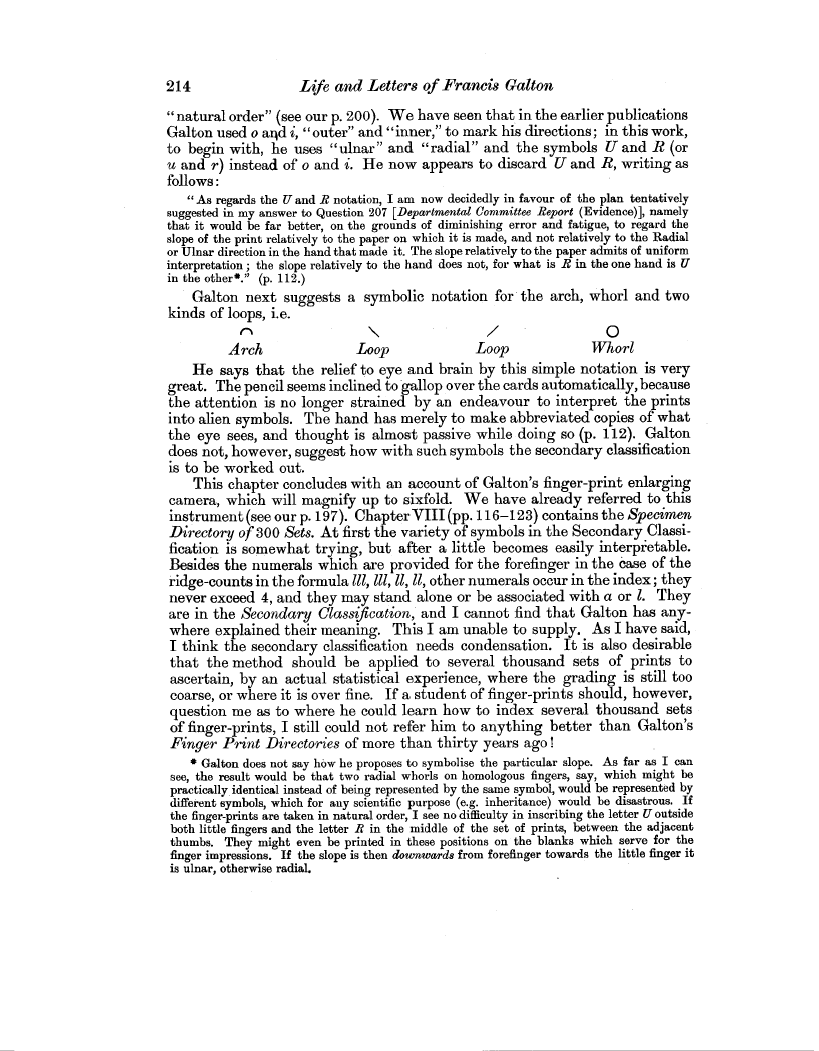| ||||||

OCR Rendition - approximate
214 Life and Letters of Francis Galton "natural order" (see our p. 200). We have seen that in the earlier publications Galton used o and i, "outer" and "inner," to mark his directions; in this work, to begin with, he uses "unar" and "radial" and the symbols U and R (or u and r) instead of o and i. He now appears to discard U and R, writing as follows "As regards the U and R notation, I am now decidedly in favour of the plan tentatively suggested in my answer to Question 207 [Departmental Committee Report (Evidence)], namely that it would be far better, on the grounds of diminishing error and fatigue, to regard the slope of the print relatively to the paper on which it is made, and not relatively to the Radial or Ulnar direction in the hand that made it. The slope relatively to the paper admits of uniform interpretation ; the slope relatively to the hand does not, for what is R in the one hand is U in the other*." (p. 112.) Galton next suggests a symbolic notation for the arch, whorl and two kinds of loops, i.e. n \ / 0 Arch Loop Loop Whorl He says that the relief to eye and brain by this simple notation is very great. The pencil seems inclined to gallop over the cards automatically, because the attention is no longer strained by an endeavour to interpret the prints into alien symbols. The hand has merely to make abbreviated copies of what the eye sees, and thought is almost passive while doing so (p. 112). Galton does not, however, suggest how with such symbols the secondary classification is to be worked out. This chapter concludes with an account of Galton's finger-print enlarging camera, which will magnify up to sixfold. We have already referred to this instrument (see our p. 197). Chapter VIII (pp.116-123) contains the Specimen Directory of 300 Sets. At first the variety of symbols in the Secondary Classification is somewhat trying, but after a little becomes easily interpretable. Besides the numerals which are provided for the forefinger in the case of the ridge-counts in the formula lll, lll, ii, ii, other numerals occur in the index; they never exceed 4, and they may stand alone or be associated with a or 1. They are in the Secondary Classification, and I cannot find that Galton has anywhere explained their meaning. This I am unable to supply. As I have said, I think the secondary classification needs condensation. It is also desirable that the method should be applied to several thousand sets of prints to ascertain, by an actual statistical experience, where the grading is still too coarse, or where it is over fine. If a student of finger-prints should, however, question me as to where he could learn how to index several thousand sets of finger-prints, I still could not refer him to anything better than Galton's Finger Print Directories of more than thirty years ago * Galton does not say how he proposes to symbolise the particular slope. As far as I can see, the result would be that two radial whorls on homologous fingers, say, which might be practically identical instead of being represented by the same symbol, would be represented by different symbols, which for any scientific purpose (e.g. inheritance) would be disastrous. If the finger-prints are taken in natural order, I see no difficulty in inscribing the letter U outside both little fingers and the letter R in the middle of the set of prints, between the adjacent thumbs. They might even be printed in these positions on the blanks which serve for the finger impressions. If the slope is then downwards from forefinger towards the little finger it is unar, otherwise radial.
|